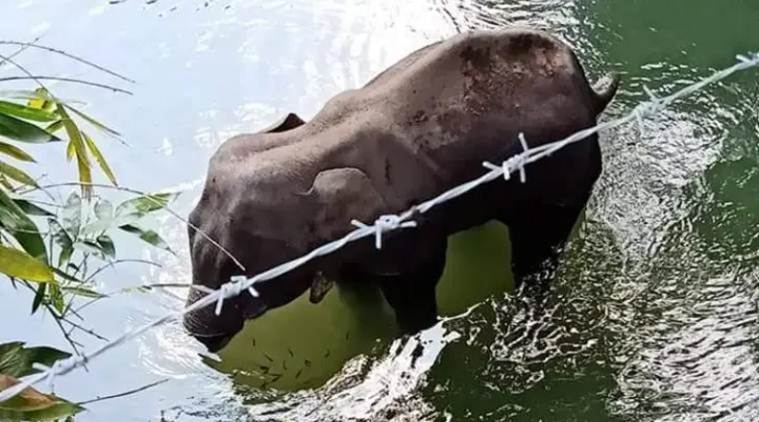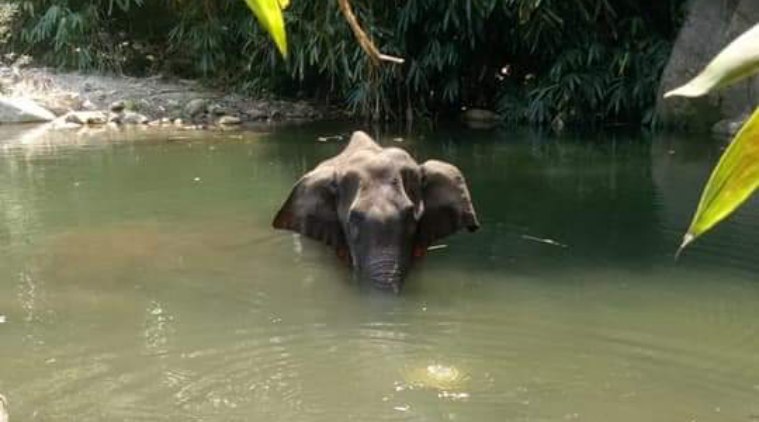 It has been alleged that the elephant was injured after it was fed a pineapple stuffed with explosives.
It has been alleged that the elephant was injured after it was fed a pineapple stuffed with explosives.
As the investigation into the tragic death of a pregnant elephant in Kerala continues, The Indian Express has learnt that forest officials had first spotted the injured animal on May 23 at a forest border.
A case under The Wildlife Act has been registered, and an inquiry is on, sources said.
The sources said that the exact spot where the elephant was injured, and who was responsible for the explosion that injured her mouth and led to her death, are yet to be ascertained.
It has been alleged that the elephant was injured after it was fed a pineapple stuffed with explosives.
On May 23, sources said, forest officials had received information about the presence of an elephant near Ambalappara at the border of Pottiyara forest in Mannarkad division in the Western Ghats.
Upon reaching the spot, the officials had seen the elephant with the injured mouth. The elephant had subsequently walked off into the woods.
Two days later, on May 25, the elephant was seen standing in a river in the Theyyamkund area, apparently to cool the wound. A veterinary surgeon who examined her, told officials that she could not be tranquillised and treated, as the injury was serious.
The forest department had concluded at the time that the injury was at least a week old. It subsequently decided to try to move it out with the help of ‘kumki’ (trained) elephants, but the injured elephant died before it could be pulled out.
The elephant’s tragic death became more distressing after a post mortem examination revealed she was pregnant. And a raging public debate ensued after Mohana Krishnan, a forest department section officer who was part of the Rapid Response Team that attempted the rescue, posted about the incident on Facebook.
 The elephant’s killing came to light on May 30 after Mohan Krishnan, a section forest officer in Mannarkkad in Palakkad district, wrote a heartfelt note on Facebook which quickly went viral.
The elephant’s killing came to light on May 30 after Mohan Krishnan, a section forest officer in Mannarkkad in Palakkad district, wrote a heartfelt note on Facebook which quickly went viral.
Officials maintained that Krishnan had not said in his post that the elephant had been deliberately fed a pineapple stuffed with explosives; he had, rather highlighted the dangers of people using explosives to ward off wild animals.
Forest officials are now combing agricultural fields bordering the Mannarkad and Silent Valley forest ranges to fix responsibility for the elephant’s death.
“The injury was already a few days old when we saw the elephant for the first time. So we have not been able to exactly pin-point the place where the injury happened. That’s the limitation we are facing,” K K Sunil Kumar, divisional forest officer, Mannarkad, said.
Officials said there was a strong possibility that the elephant fell victim to a snare laid to kill wild boars and pigs. “In the forest fringes, there have been reports of crackers and country-bombs being used to trap and kill pigs and other wild animals. It could be that the elephant accidentally ate it,” an official said.
Another forest official said since an elephant can walk up to 100 km in a day, it could have travelled far from the spot where it was injured. “It (the spot) would be difficult to find unless we get a clue.”
Shashi Kumar, a deputy range officer with the division, said incidents of explosive traps for pigs and boars used to be frequently reported earlier.
“But since we began filing cases, such incidents have dropped. In our division, hardly any such incidents are reported,” he said.